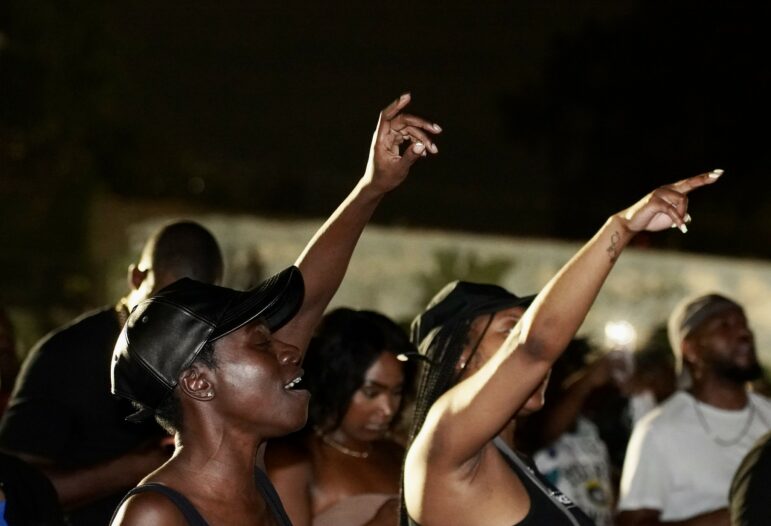“The need for parks where everyone feels welcome is vital. The COVID-19 pandemic underscored the value of greenspaces, as people of all backgrounds flocked to local parks to safely exercise and socialize. And somewhere right now, there are young people whose creative juices are in search of a safe outlet.”

Benny Polatseck/Mayoral Photography Office
Wingate Park in Brooklyn in 2022, where the city hosted part of its “Rise Up NYC” concert series.
The address 1520 Sedgewick Ave. is famous in the annals of hip-hop. It was there, on Aug. 11, 1973, that the art form was born in a basement rec room in the South Bronx. Billed as a Back-to-School Jam, the party was hosted by Cindy Campbell and her brother, DJ Kool Herc, a Jamaican-born graffiti artist, dancer, and disc jockey.
What is perhaps less well known is that the party became so crowded, it had to move to nearby Cedar Playground. That spawned a phenomenon known as park jams that took place not only in the Bronx, but in green spaces in Brooklyn and Queens, and before long, throughout urban America.
On the cusp of Sept. 23, where we recognize Public Lands Day and continue to toast hip hop’s 50-year legacy, we’re not just celebrating two seemingly disparate milestones, but also reflecting on how America’s diverse landscapes have been enriched by the enduring and transformative influence of Black culture. Moreover, it underscores the crucial need to preserve and uplift the stories and voices of Black Americans within our nation’s network of parks, protected lands, and historical sites.
That parks played such a pivotal role in the genesis of hip-hop should come as no surprise. Young black and brown teenagers were the pioneers of the cultural earthquake whose music, fashions and politics would soon spread to mainstream America.
Unlike nightclubs and bars, parks were free and also available to young people of all ages. In the early days of hip-hop, parks were also less regulated and less policed. Spontaneous gatherings could happen without the risk of noise complaints or police crackdowns and, often, without the need for permits. Resourceful rappers tapped into lampposts in parks to secure the electricity needed to power turntables and speakers.
Parks have long been a venue for free expression. In the 19th and early 20th centuries, political activists mounted soap boxes—literally the packing crates used for shipping soap—to express their views in parks. In cities, where backyards are scarce, parks represented a safe space where children and teens could learn to be social creatures.
The development of hip-hop combined both the political and the social. Song lyrics castigated everything from hyper-policing to mass incarceration, while celebrating the energy and creativity percolating in housing projects and, yes, parks. The legendary MC Shan famously rhymed: “Hip-hop—was set out in the dark/They used to do it out in the park.”
It wasn’t long, however, before hip-hop gatherings and park jams themselves fell victim to the “broken windows” approach to policing.
Writing in the Washington University Political Review, Hussein Amuri asserts that the “criminalization of hip-hop is a widely used tool meant to silence and break down Black and brown communities,” adding that such suppression removed a platform “used to call out the injustice inflicted on them.”
Still, the celebration of the 50th anniversary of hip-hop by none other than the New York City Parks Department—in a fact-filled blog posted on its website—speaks to hip-hop’s enduring role in American life. Cities like New York continue to provide hip-hop artists with stages in parks for honing and expanding their music. These events may be officially sanctioned and therefore sanitized, but the outdoor concerts now feature elaborate set-ups and high-octane sound systems.
Similarly, the City Parks Foundation’s concert series, SummerStage, has for years made hip-hop a centerpiece of its offerings. High-profile concerts have included the late rapper Prodigy in Queensbridge Park, Nas in Manhattan’s Central Park, and KRS-One in Brooklyn’s Coffey Park. Last year Mayor Eric Adams launched a concert series called “Rise Up NYC,” billed as “five boroughs, eight events” and studded with hip-hop artists. It returned this summer in park locations that, refreshingly, have not yet been swamped by the tide of gentrification.
The need for parks where everyone feels welcome is vital. The COVID-19 pandemic underscored the value of greenspaces, as people of all backgrounds flocked to local parks to safely exercise and socialize. And somewhere right now, there are young people whose creative juices are in search of a safe outlet.
Fifty years from now, we might be commemorating the birth of another art movement that found its footing in public parks. From Oakland, California to Bridgeport, Connecticut, and everywhere in between, we need to invest in and expand our park and public lands systems so that young artists have a place to go, especially when they lack the space or freedom to explore their art and connect with peers elsewhere. Our culture depends on it.
Dr. Jocelyn Imani is a historian, community advocate, singer and the National Director of Trust for Public Land’s Black History and Culture Initiative.

